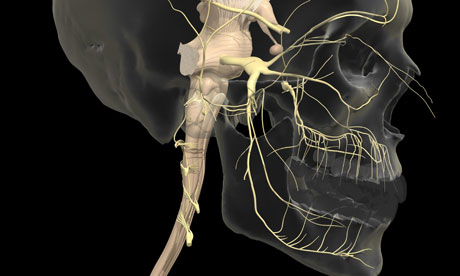
The number of injuries and illnesses associated with pain is inestimable. But only one is so unbearable that patients are known to be at a considerably higher than usual risk of suicide. This condition affects the trigeminal nerve.
The trigeminal is the fifth and largest of a set of 12 cranial nerves that leave the brain via an array of holes in the skull. A paired nerve, it has three main branches, referred to as the ophthalmic, maxillary and mandibular divisions. Its main function is to provide sensation to the face, but it also controls the muscles used in chewing.
Trigeminal neuralgia occurs mainly in older women, and is thought to be caused by a blood vessel causing pressure on the nerve as it leaves the brain through the skull. Its main feature is pain, often piercing, which tends to affect the lower two-thirds of one side of the face. Symptoms may be set off by something as minor as a breeze passing across the skin, and can occur without warning. Attacks last from seconds to days and recur at random. Treatment is with drugs more commonly used for epilepsy, or surgery.
The worst disorder to affect the fifth nerve is the cluster headache, which often occurs in acute periods, separated by symptom-free times. Pain occurs around the eye and is excruciating. Many experts think it is the most agonising condition known to humankind. These headaches are also thought to arise from pressure from vessels on the nerve. Dysfunction of an area of the brain called the hypothalamus, low testosterone, genetic susceptibility and smoking are cited as possible risk factors. To abort attacks, patients may take tablets, inhale high concentrations of oxygen, meditate, exercise – or even have sex.
Gabriel Weston is a surgeon and author of Direct Red: A Surgeon's Story

